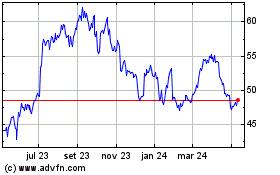US Oil-Field-Service Cos Push To Improve Fracking Efficiency
27 Junho 2011 - 2:22PM
Dow Jones News
With energy producers expected to spend a record amount of money
this year looking for and extracting oil and natural gas,
oil-field-service companies are being stretched thin.
Heightened demand, along with a desire to lower costs and lift
profit margins, have companies including Halliburton Co. (HAL) and
Schlumberger Ltd. (SLB) racing to become more efficient.
Weatherford International Ltd. (WFT), for example, is
introducing rubber and metal packing materials to replace
traditional cement well casings, which cause delays as crews wait
for them to cure. Halliburton, meanwhile, is tipping sand-filled
tractor trailers on end to save space at well sites and to allow
gravity, rather than diesel engines, to empty them of the material
used to prop open shale fractures.
"This is the time to invest in cutting our costs," Halliburton
Chief Financial Officer Mark McCollum told investors during a
recent conference. The efforts are focused particularly on reducing
the time and money needed to unlock unconventional fuel reservoirs
through horizontal drilling and hydraulic fracturing, or fracking.
These recently developed techniques require a lot of manpower and
resources, and they play an increasing role in supplying the
world's energy needs.
What are known as the Big Four oil-field-services
companies--Halliburton, Schlumberger, Baker Hughes Inc. (BHI) and
Weatherford--have boosted their capital spending by 40% to keep
pace with producers and to develop resource-saving technology, said
James West, an analyst with Barclays Capital.
Still, West said, spare oil-field-service capacity "will mostly
be erased by the end of this year," as exploration and production
spending tops $500 billion.
Oil and natural-gas producers are already feeling the strain. In
some cases, they are waiting months between initial drilling into
shale formations and the arrival of hydraulic-fracturing equipment
needed to complete wells and start production. This has placed a
premium on how quickly service providers can perform fracking
services.
Schlumberger, for instance, touts new automated fracturing
technology that allows it to perform several tasks deep inside
wells with one tool instead of the several it used to take. By not
having to snake separate tools in and out of the miles-long well
bores, Schlumberger is able to complete fracking jobs that once
took 20 hours in half that time.
"We can save a full day of the [fracking] crew on the location
just because we can do things faster than they've been done
before," said Valerie Jochen, technical director for Schlumberger's
Unconventional Resources unit.
Weatherford is investing heavily in technology to study shale
formations before drilling begins so that only the most productive
areas are fractured, said Nicholas Gee, who heads the company's
reservoir and formation evaluation unit.
"Up to now, people have just generally drilled a well and then
fracked everything," Gee said.
Halliburton late last year launched an initiative to reduce
well-site personnel by 35% and to trim well-completion time by 25%
by 2013, measures aimed at cutting costs.
Some of the Houston company's efforts have involved developing
new technology, such as portable ultraviolet-light units designed
to eliminate pipe-corroding bacteria from fracking fluids. That
eliminates the need to using hundreds of thousands of gallons of
bacteria-killing chemicals. Other efforts have involved simply
rethinking the relatively mundane, such as turning the sand-filled
tractors on end, said David Adams, who heads Halliburton's
production-enhancement division.
"It's funny, but it was a novel concept," Adams said.
Delivering faster, more efficient fracturing not only helps
Halliburton meet surging demand for such services now but it
ensures that "we can still maintain margins as we go through
downturns," Adams said.
So far, Halliburton has been able to pass along to its customers
the cost increases that come when demand outstrips supply, he said.
But producers will probably be less accepting of price increases if
oil prices fall.
Producers can make money if oil drops as low as $60 a barrel,
but oil at $80 a barrel would affect cash flows enough that many
producers might reduce drilling, said Dahlman Rose & Co.
analyst James Crandell.
Oil has slid more than 20% from the $114-per-barrel highs seen
in April. On Monday, light, sweet crude oil for August delivery
recently traded 34 cents lower at $90.82 per barrel on the New York
Mercantile Exchange.
-By Ryan Dezember, Dow Jones Newswires; 713-547-9208;
ryan.dezember@dowjones.com
--Angel Gonzalez contributed to this article.
Schlumberger (NYSE:SLB)
Gráfico Histórico do Ativo
De Jun 2024 até Jul 2024

Schlumberger (NYSE:SLB)
Gráfico Histórico do Ativo
De Jul 2023 até Jul 2024
